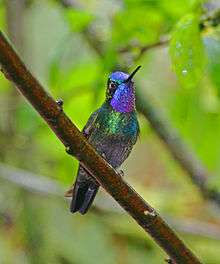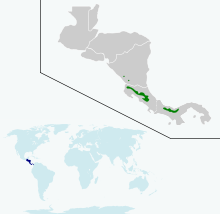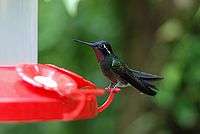Purple-throated mountaingem
| Purple-throated mountaingem | |
|---|---|
 | |
| Male in Costa Rica | |
| | |
| Female in Costa Rica | |
| Scientific classification | |
| Kingdom: | Animalia |
| Phylum: | Chordata |
| Class: | Aves |
| Order: | Apodiformes |
| Family: | Trochilidae |
| Genus: | Lampornis |
| Species: | L. calolaemus |
| Binomial name | |
| Lampornis calolaemus Salvin, 1865 | |
 | |
| Range of L. calolaemus | |
| Synonyms | |
|
Lampornis calolaema (lapsus) | |
The purple-throated mountaingem (Lampornis calolaemus) is a hummingbird which breeds in the mountains of southern Nicaragua, northern Costa Rica and western Panama. This bird inhabits forested areas in hilly terrain, and is found at altitudes from 800 to 2,500 m (2,600 to 8,200 ft).
It is replaced in southern Costa Rica by its close relatives, the white-throated and gray-tailed mountaingems, with which it is sometimes considered conspecific.[nb 1] These three species form a closely related group that evolved some 3.5 million years ago and has diversified since.[3]
Description
It is 10.5 cm (4.1 in) long. The male weighs 6.0 g (0.21 oz) and the female 4.8 g (0.17 oz). The shortish black bill is slightly curved.
The adult male has bronze-green upperparts and underparts except for a brilliant green crown, purple throat and dark grey tail. The female lacks the bright crown and throat, and has rich cinnamon underparts. Young birds resemble the female but have buff fringes to the upperparts plumage.
The call of this species is a sharp buzzy zeet.
Ecology

The food of this species is mainly nectar, taken from a variety of flowers.[nb 2] For the Rubiaceae Psychotria elata and Palicourea lasiorrachis, it is the default pollinator.[4] Like other hummingbirds it also takes small insects as an essential source of protein. Male purple-throated mountaingems defend flowers and scrubs in their feeding territories, and are dominant over most other hummingbirds.
Females have slightly longer bills than males. There is some degree of niche differentiation between the sexes. Though both prefer flowers with a corolla 14–21 mm (0.55–0.83 in) long by 3.5–8 mm (0.14–0.31 in) wide, females far more often than males utilize plants with longer[nb 3] and thinner[nb 4] corollas.
The female purple-throated mountaingem is entirely responsible for nest building and incubation. She lays two white eggs in a deep plant-fibre cup nest 0.7–3.5 m (2.3–11.5 ft) high in a scrub, small tree or vine. Incubation takes 15–19 days, and fledging another 20–26.
Notes
- ↑ Some taxonomies refer to this lumped species as the variable mountaingem (Lampornis castaneoventris).[2]
- ↑ Namely Stenostephanus blepharorachis (Acanthaceae), Besleria formosa and Besleria triflora (Gesneriaceae), Palicourea lasiorrhachis and Psychotria elata (Rubiaceae). Other foodplants include assorted Alstroemeriaceae, Bromeliaceae, Campanulaceae, Ericaceae (e.g. Psammisia ramiflora), Heliconiaceae and Zingiberales.[4][5]
- ↑ Up to c.40 mm (1.6 in), e.g. Guzmania nicaraguensis (Bromeliaceae).[5]
- ↑ Up to c.20 times as long as wide, e.g. Dicliptera trifurca (Acanthaceae), Burmeistera tenuiflora (Campanulaceae).[5]
References
- ↑ BirdLife International (2012). "Lampornis calolaemus". IUCN Red List of Threatened Species. Version 2013.2. International Union for Conservation of Nature. Retrieved 26 November 2013.
- ↑ Stiles, F.G. (2014) [1999]. del Hoyo, J.; Elliott, A.; Sargatal, J.; Christie, D.A.; de Juana, E., eds. "Purple-throated Mountain-gem (Lampornis calolaemus)". Handbook of the Birds of the World Alive. Barcelona: Lynx Edicions. Retrieved 12 May 2015. External link in
|website=(help) - ↑ García-Moreno, Jaime; Cortés, Nandadeví; García-Deras, Gabriela M.; Hernández-Baños, Blanca E. (2006). "Local origin and diversification among Lampornis hummingbirds: A Mesoamerican taxon". Molecular Phylogenetics and Evolution. 38 (2): 488–498. PMID 16257241. doi:10.1016/j.ympev.2005.08.015.
- 1 2 Fenster, Charles B. (1991). "Selection on Floral Morphology by Hummingbirds". Biotropica. 23 (1): 98–101. doi:10.2307/2388696.
- 1 2 3 Temeles, E.J.; Linhart, Y.B.; Masonjones, M.; Masonjones, H.D. (2002). "The role of flower width in hummingbird bill length-flower length relationships" (PDF). Biotropica. 34 (1): 68–80. doi:10.1111/j.1744-7429.2002.tb00243.x.
- Stiles, F. Gary; Skutch, Alexander F. (1989). A Guide to the Birds of Costa Rica. Comstock Publishing Associates. ISBN 0-8014-9600-4.
External links
| Wikimedia Commons has media related to Lampornis calolaemus. |
| Wikispecies has information related to: Lampornis calolaemus |
- Interactive range map of Lampornis calolaemus at IUCN Red List maps
- Purple-throated Mountain-Gem photo gallery at VIREO (Drexel University)
- Purple-throated Mountain-gem species account at NeotropicalBirds (Cornell University)
